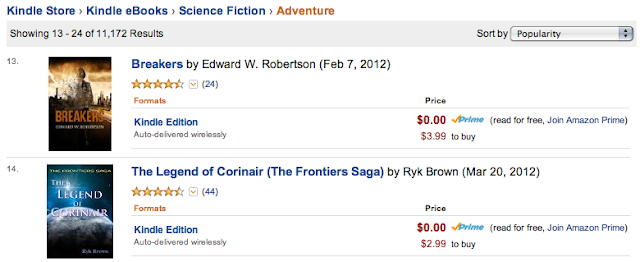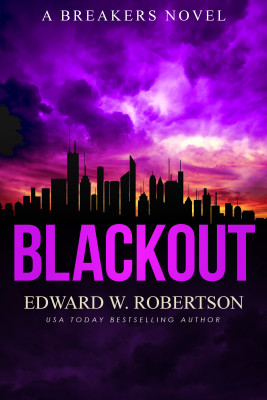So we’re now three weeks into Amazon’s most recent set of algorithms. I don’t know the first thing about what they’ve meant for the overall activity of the Kindle store, but in terms of books in the Select program and free giveaways, some trends are starting to emerge. And they generally aren’t too favorable.
Yet they aren’t completely disastrous, either (depending on your definition of “disaster,” anyway). Phoenix Sullivan has a week’s worth of data on ten different titles showing a 500% increase in income in the week after her most recent free runs. At the same time, she sees that it now takes a significantly higher number of downloads to see increased sales.
Over at the Kindleboards MEGA-THREAD devoted to the tracking of free data, results are kind of all over the map, but show persistent evidence of decreased post-free sales. (Link goes to results posted after the May 3 changes; when browsing, make sure to look for free runs that took place after that date.) Still, it’s also showing that post-free sales haven’t dried up completely. Meanwhile, Russell Blake, who’s been doing pretty well for himself in part due to free runs and is touch with a bunch of other authors, has mentioned post-free sales are only about 10% of what they used to be back in the glory days. In the episode of the Self-Publishing Podcast I was on, Johnny B. Truant mentioned he’d recently given away 8000 copies and seen no appreciable sales bump. After what Phoenix has termed the Golden and Silver Ages of Select, these diminished numbers are fairly discouraging.
But here’s something else that appears to be a part of the new system:
This is Breakers‘ entire sales history, dating back to its release on February 7. Now let me doctor the charts a little bit:
The two red bars mark the approximate dates of algorithm changes. 0, 1, 2 all fell during the days of List A; 3 took place during the days of List A/B/C; 4 is what we’re seeing with the most recent set. 0 was the release date. 1, 2, and 4 came after free runs. 3 was an ad/sale price promo.
The pattern’s pretty clear, right? Under the old algorithms, books would peak, then gradually decline over the next few days until they returned to Spiky Land, where sales are few and inconsistent. (My Spiky Land sales rate was generally 0-6 per day.) The trajectory looked like the flight of a lofty home run ball in reverse–a swift rise, then a steady downward slope. Since my latest free run under the new algorithms, however, the sales trajectory is more like.. the path of a torpedo. A sexy torpedo. One that doesn’t show any major signs of slowing down.
For another three weeks, anyway, which is when things will get really interesting. What’s happening here is this. Breakers gave away 2.5 shitloads of books on its last free run (where a “shitload” is defined as 10,000 copies–note that we’re using customary measurements, not the Imperial scale). Right before it was free, its popularity list rankings were #121 in Thrillers > Technothrillers and worse than #500 in Science Fiction > Adventure. Where is it now?
Technothriller isn’t the biggest category in the Kindle store, but SF > Adventure is a pretty tough one. This is the category where George R.R. Martin and Wool chew everyone else up and drool them down their sales-fattened bellies. Yesterday, Breakers was actually #12–page 1!–but a new release from Amazon’s 47North imprint vaulted ahead of it today.
Here’s the difference between the old algos (List A) and the new. When Breakers came off free, it would have vaulted to #1 in both categories. It probably had enough downloads that it would have hit page 1 of the entire Mystery & Thrillers genre. This would have produced a rush of sales (almost certainly hundreds), but after a few days, its rank would start to decay. It would get leapfrogged by the latest post-free books off big runs of their own. Within about a week–maybe two, given a giveaway of this magnitude–it would probably be back down near its former rank and sales.
If anything, the opposite is true now for big giveaways. Initially, Breakers hit Technothrillers at #12 and Adventure at #27. It hadn’t sold much over the 30 days prior to being free. 110ish copies, I think. The new pop lists look at a 30-day rolling window of sales. Once it reverted to paid, then, its pop list placement was calculated based on 25K freebies + 110 sales. But since its free run, it’s been selling 70+ copies per day. As the 30-day window advances, then, last month’s low sales days are discarded from the equation while its most recent high sales days are added to it. The result: it has steadily climbed the pop lists ever since.
By now, it’s probably about peaked. And in another 3 weeks, those 25K freebies will roll beyond the window. At that point, it will drop down the pop lists again. How much? That will be determined entirely through how many copies it sold over its new 30-day window. But if that arrow-straight sales line from its sales history holds out, we’d be talking somewhere in the neighborhood of 1500-2000 copies–in other words, enough that it’ll probably still be somewhere on page 1 of Technothrillers, and probably page 3 of SF > Adventure. That would still be a lot of pop list visibility.
In other other words, it could get sticky.
Assuming the algos don’t change over that time, of course. And that I don’t get 50 consecutive one-star reviews. And that the collective unconsciousness doesn’t decide Breakers is 300-some pages of garbage and that its author should be defenestrated with all possible haste. Or that interest doesn’t simply dry up. The U.S.S. Me could be torpedoed at any time.
Back to the big picture. In general, Select is no longer as effective at generating sales as it was just last month. The visibility produced by most giveaways is much lesser than it was before. But if you get lucky enough, that visibility will last for much longer. More visibility, more sales. While in most cases, Select is the least useful it’s ever been–and part of me isn’t happy about that at all–in certain instances, it’s become a more powerful tool than ever.













Leave a Reply